
In the classic scene from the film “The Wrath of Kahn” the embattled crew of the Starship Enterprise sits crippled in interstellar space, hiding in the Mutara Nebula as the superhuman Khan Noonien Singh, who cleverly acquired his own Federation spaceship hunts Captain Kirk and his valiant crew. Both were nearly blind in the stellar fog of the nebula.
“He’s intelligent, but not experienced,” Spock sagely remarks, “but his pattern indicates… two-dimensional thinking.”
With that thought bomb lobbed onto the deck, James Tiberius Kirk went on to vertically swoop in on Khan and put the smack down on Khan’s spacejacked Starship Reliant, which by this time was no doubt upholstered in rich Corinthian leather. Kirk, again wins the day.
It’s a classic reframing exercise. One party is thinking with one set of assumptions another is exploiting that blind spot. What blind spot is your competition exploiting in your retailing experience?
Most of us experience the world with at least five senses, likely many more. When it comes to retail design, we have many who are Khan-like laser focused[1] on designing primarily to only one or two of the five senses. However, there are quite a few retailers (both online and brick and mortar) who do an amazing job investing in others and in so doing, reaping the benefits in terms of sales. Let’s take a look.
Sight
The most obvious, and perhaps the most important sense to appeal to in retailing is sight. According to William Allyn professor of Medical Optics, more than 50% of the brain cortex is dedicated to the visual processing of information. It turns out that visual perception is an incredibly complex process that enables one to see very small distinctions.
As such, visual design is and should be on the top of the list when creating experiences. As a species we are attracted to things of beauty. Where beauty is many times culturally determined, we know that humans like order, patterns, symmetry, simplicity, obeying the principles of the ‘golden ratio’ and often organic shapes and curves over more clinical one. There are libraries written on the topic.

Online retailers have a very distinct disadvantage over physical retailers where, at best, they have access to two of the 5+ senses; see and hear. Therefore, these retailers have to be really good at this aspect of retailing.
Warby Parker does an exceptional job in the pre-trial, trial, and purchase of eyeglasses. They make accessibility to their product easy. You can go right to a virtual trial or take a quiz to see what kind of style you might like or just jump right into it.
Within seconds you are trialing their enormously long tail inventory.
Pick a few out and they will then send you a bunch of eyeglasses to your house to try on, for free, so you can make the final decision.
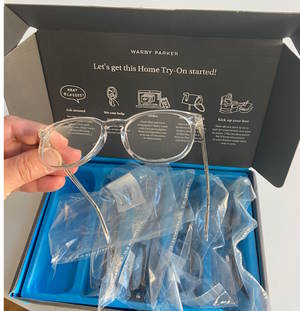
You don’t even need to upload your prescription unless you decide to buy. It’s a clever and effective e-tailing experience that has been embraced by millions. More than ‘eliminating the friction’ they make the experience of shopping fun, engaging, and easy.
Warby Parker and other e-tailers who make use of the interactivity of visual medium coupled with increased convenience (I don’t have to go anywhere) makes it a popular destination for selecting eyeglasses and other eyewear. Cosmetics such as Maybelline, apparel, and even furniture companies such as Charish do a nice job of letting you try things on virtually.
Sound
In undergraduate school, I was obsessed with the use of environmental psychology to influence human behavior. I guess I still am.
While the sub-second flash of a picture of popcorn during movies to influence concession purchases was largely disproved, other interventions such as the use of music in grocery and restaurant settings do influence behavior at perhaps a subliminal level.
Music is probably the best recognized use of sound in retailing. We find trip-hop and ‘chill’ music in high-end stores, mainstream or classics in grocery stores (Walmart has their own music channel they play in-store), and of course loud house or R&B in many bars. Studies have found that tempo has an impact on browse time in stores. Want to turn tables quickly, perhaps a nice upbeat Samba. Want people to peruse that cheese island by the deli more leisurely, perhaps play some smooth slow tempo jazz stylings.
Also you can modulate sound volume in much the same way you can use light, using it to sublety petition spaces in a retail setting. Perhaps louder and more enveloping when immersed in shopping and quieter when interaction is required.
Some consumers may appreciate quiet areas in retail, such as in a library. Quiet tends to be contagious and is often dictated by the behavior setting. We are quiet in libraries, bookstores, places of worship, and museums because that is a social norm. Can you leverage these social norms in your retail space?
These quiet zones are especially appreciated in contexts in which we are trying to be productive or communicate in noisy locations such as airports or city streets.
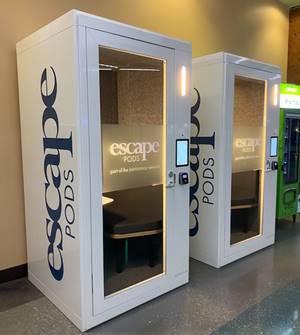
More recently innovations such as Escape Pods offer a refuge to conduct that business meeting in solitude away from prying eyes and ears and the loud PA announcements in airports.
While there is much new technology used in support of a brand in store, there is also something to be learned from more traditional retailing; the welcoming jingle of a bell on the front door, the quite muffled sound of a baseball game in a barber shop, or the soothing sound of waves from an ocean side restaurant all can be used reinforce both the store atmospherics as well as the brand.
There is so much more to an auditory experience in store than Muzak and Hootie and the Blowfish. This is an area of opportunity in environmental design.
Smell
If you are making your way to Hershey Pennsylvania you will know you are close when you start smelling chocolate. The entire town smells like chocolate. Scents are also overlooked in retailing, yet there is something very powerful and primal about smells. Neuroscience has revealed our detection of odors is directly connected to our limbic system which is where emotions live in our brains. This makes smells especially powerful in creating memorable experiences.
Take a moment to think about to some smells you remember and how they connect back to memorable experiences. Here are a few that come to mind for me:
- The powerful sweet grape Bubblicious smell of junior high dances
- The smell of bacon wafting out of homes on a morning run
- The cozy smell of pipe smoke of my best friend’s dad when I was a child
- The smell of Creosote bushes and wild Fennel in the high desert of California
- The smell of rain on hot macadam right after a thunderstorm
They bring back many memories.
In experiential design, some of these are purposefully designed in while others are happy accidents. Back when I was very young the local A&P grocer would grind coffee in the checkout lane, which was a great way to depart from the store. The smell of freshly roasted peanuts or the pungent smell of vinegar on French fries at the state fair creates long lines. The smells are invariably better than the food itself. Our sense of smell is even more powerfully connected to negative hedonic experiences, such as the smell of death, which most species have hard-wired to detect and avoid.
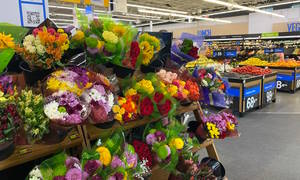
Smart retailers know how to use this. It is most prominently used in Hospitality to complement the experience. For example, Westin has used the scent of cedar and white tea since 2006 to welcome guests. By accident or purpose, restaurants are also adept at using smell to entice tourists to come in and try the food. Street vendors rely on the sweet smell of grilled onions, peppers, and beef to attract customers. Some more adept grocers put flowers in the front of the store to both welcome customers and mask the subtle smell of rotting produce.
I often found it strange that other retailers don’t bother with this sense. High-pressure settings such as catering, financial transactions, and high-price purchases such as vehicles and shopping for a new home could benefit from a calming fragrance. In selling a few houses over the years, we always made it best practice to bake cookies right before any open house. Not sure if it worked, but the cookies were always gone upon our return, and we always sold the house.
It is probably not an accident that in male-dominated industries the use of smell is less utilized than those more dominated by women (such as hospitality, dining, and leisure) smell is used more effectively. Research has found ample evidence the women have superior olfactory capabilities which retailers should also consider as they reflecting on their customers.
Pleasant smells can be achieved without the use of complex technologies. Candles, plants, and well-timed cooking can all achieve a pleasant olfactory experience with minimal expense. An interesting article by Michael Keenan highlights different types of scent marketing strategies including Aroma billboards, Ambient scenting, Thematic scenting, and Signature smells. Retailers claim real results using these tactics in creating stronger retail performance.
Taste
Closely related to our sense of smell is our sense of taste. While expensive, retailers have long known the power of the sample. I remember years ago being curious about a long line forming in Charles De Gaulle airport. Having some time on my hands, I wandered over to see what was going on. I asked a middle-aged man in line what he was waiting for.
“The cookies! They are zee best cookies in zee world!” he told me.
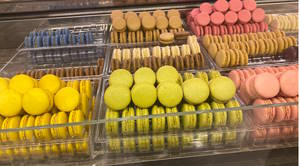
Intrigued, I got in line and received a sample. They were, indeed, one of the best cookies I ever tasted. Unbeknownst to me I had personally discovered the vaunted confectionary Maison LaDurée, that so many Europeans love.
I fell in love with them and upon returning home to the United States was horrified that they only sell them in retail outlets and not online[2]. More disturbing was they had very limited distribution in North America.
If you are in the business of selling things that people eat, the best thing you can do is to get them to eat it. If it’s good, they will be back.
Touch
Another advantage that brick-and-mortar retailers have over e-tailers is touch. Sure, we can use sophisticated AR and VR to approximate the retail experiments, but you cannot figure out the ripeness of an avocado, feel the texture of fabrics, or feel and hear the satisfying revving of a sports car engine virtually.
Clothiers tend to do an exceptional job of this. Take for example, this well-organized selection of sweaters at Black Goat Cashmere in Victoria, BC.
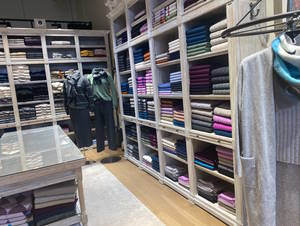
I’m afraid Amazon doesn’t have a chance against this experience. While my groping the colorful selection in this store probably brought the ire of the shopkeeper, it was nonetheless a pretty immersive experience.
Another important aspect of touch is trial. There are certain categories where experience is critical. Apparel, sporting goods, toys, and high-end goods are all great candidates for exploiting a tactile experience.
In-store experience of touching and more importantly using products will inevitably lead to higher conversation rates.
The Gestalt of Experience
While it is important to pay attention to each of the senses, the real trick is putting them all together into a holistic and consistent in-store (and omnichannel) experience. Starbucks Seattle Roastery in Seattle is an amazing example of doing just that. A few blocks away from the original Starbucks, the Roastery is an immersive brand experience that also pays homage to the local culture.
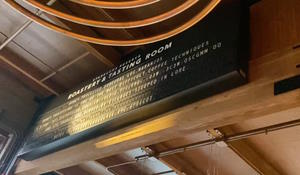
Using of local wood and complementary tones in design makes for a cozy and quintessential coffee house vibe. They purposely invoke all the senses in the design. The smell of coffee is enveloping but not overpowering. The quiet sound of modern hip music mixed with the murmur of conversations and the gentle till of coffee beans after being roasted can be heard.
They have an old-style 1930s split flap display that clicks new personalized messages every few seconds, welcoming groups and conveying information in an interesting and dynamic fashion.
Shapes of the furniture are design salutes to the local culture. Many of the lamps are shaped like the Space Needle, the entryway is composed of giant sized coffee stirs, and there are sound baffles shaped like coffee filters on some of the walls.

You are encouraged to talk with staff and experience the product, including exclusive products only available in that location. You can buy snacks; savory or sweet, which we did.
In our visit, the staff was knowledgeable and courteous, and the layout encouraged exploration, social interaction, or solitude to read a book or write a blog.
I spent a few minutes talking with the barista about yet another way to brew coffee… and I don’t even really like coffee.
Overall, an amazing and thoughtful layout and experience.
While not everyone has the money to pull off a Starbucks Roastery experience, it is an aspirational goal. However, I don’t think an immersive sensory experience needs to be expensive, just thoughtful.
One of my favorite barbershops in Redondo Beach, Riviera Barbershop, does it fine with much less extravagance.

At Riviera you have the banter of three white smocked tattooed barbers with either rockabilly music or a Dodgers baseball game on in the background. You can grab a cold cerveza anytime for free from the fridge, or on Fridays a shot of Tequila.
The smell of aftershave and hair products permeates the air, but not in a bad way. It smells clean and reminiscent of a time gone by.
Then you have the layout.
Total retro barber shop meets Social Distortion, complete with a wooden Indian and a squirrel named Chip outside. Pictures of various celebrities, including a host of obscure b-celebrities from the 80s and 70s, adorn the wall. In the cabinet up front are a bunch of old-school straight razors, and traditional shave cremes such as Barbasol and Plisson shaving brushes.
The barbers are part of the show, extorting fringe theories on all manner of current events and the merits and demerits of the Dodger baseball lineup this year. You don’t have to even talk, you are an extra in a local theatre production. The haircut is a byproduct of your visit.
Retail experiences from a small local barbershop to a large global corporation can all pull off an immersive sensory experience. It’s just a matter of planning and then conscientiously executing to create that experience for your customers. What senses are you neglecting in your retail experiences? What are some of your favorite examples of sensory immersion.
Notes
[1] Or perhaps Photon Torpedo focused?
[2] They now will deliver them in 24 hours in the United States
Image credits: All photos taken by Dave Fish



